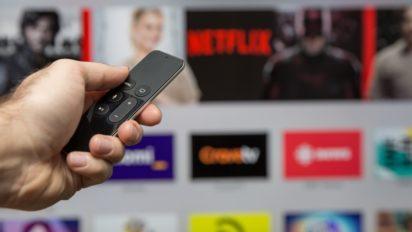
Best streaming services of 2024
We’ve compared and rated our favorite streaming services, including live TV streaming services such as Hulu + Live TV, DIRECTV and YouTubeTV. Find out if cord-cutting is right for you!
Compare the best streaming services
Streaming movies and shows is easier than ever before. You can pick from live TV streaming services that bring cable channels to your TV through your internet connection or video streaming services like Netflix to play entirely on-demand content. Prices can range from $4.99/mo. up to $80/mo., depending on factors like streaming without commercials, including live channels, original programming and more. Here are the top services available nationwide.
Our top 3 streaming picks
- Best for live TV: YouTube TV
- Best for on demand streaming: Netflix
- Best cheap streaming option: Sling TV
How we chose the best streaming services
We looked at affordability, value, channel count, contract length and original content in order to determine which streaming services were the best options available. We broke down this analysis into several categories so that all shoppers are able to find the best TV service based on their needs. For that reason, we differentiated between the best live TV streaming service, the best on demand streaming service and the best cheap streaming service option.
Popular streaming packages
-
![]()
Starting at $6.99/mo.
Our overall score: 8.7/10
“Netflix is the best video streaming service overall. It has the best mix of original and licensed content around, and its technology is in a class of its own.”
-
![DIRECTV logo]()
Starting at $64.99/mo.*
Our overall score: 8.5/10
“While DIRECTV is more expensive than other live TV streaming services, you’ll get the best channel lineup in streaming and a simple-to-use, all-in-one device.”
-
![YouTube TV logo]()
Starting at $72.99/mo.
Our overall score: 8.8/10
“Other live TV streaming services have slightly better channel lineups, but YouTube TV closes the gap with its outstanding user experience.”
-
![]()
Starting at $74.99/mo.
Our overall score: 8.4/10
“fuboTV isn’t a good option for fans of American sports, but it has one of the best overall channel selections of any live TV streaming service.”
-
![]()
Starting at $25.00/mo.
Our overall score: 6.8/10
“Philo is the only skinny bundle to include DVR storage, but other live TV streaming services have better channel lineups for cheaper.”
-
![]()
Starting at $7.99/mo.
Our overall score: 7.6/10
“With plenty of news, sports and family channels in addition to its on-demand service, Hulu + Live TV provides a solid experience overall.”
-
![]()
Starting at $40/mo.
Our overall score: 6.8/10
“Sling is one of the cheaper options around for live TV streaming, but you won’t get popular channels like ABC, CBS or most regional sports networks.”
*Plus taxes.
Compare top streaming packages
If you’re having trouble deciding which services to add, our experts have done the research on details like channel lineups, content offerings, simultaneous streams and more. Compare some popular options below.
| Streaming providers | Number of movies | Number of TV shows | Movies in IMDb Top 250 | TV shows in IMDb Top 250 |
|---|---|---|---|---|
| MAX | 2,047 | 613 | 61 | 46 |
| Netflix | 3,714 | 1,941 | 26 | 60 |
| Hulu | 1,172 | 1,254 | 11 | 61 |
| Prime Video | 66,021 | 10,853 | 24 | 36 |
| Disney Plus | 953 | 325 | 15 | 4 |
*According to data from JustWatch.com (05/05/23)
YouTube TV is $72.99/mo. with no long-term contracts or equipment fees. You get 100+ live TV channels. We like YouTube TV because they have the best channel lineup for news, sports, comedies, dramas and more. They are also the exclusive carrier of the NFL Sunday Ticket.
Netflix plans range from $6.99 to $22.99/mo. with no extra costs and no contracts. Netflix offers movies, documentaries, TV shows, anime and original content. Netflix is known for its nearly flawless interface.
Sling TV has three packages: Orange ($40/mo.), Blue ($40/mo.) and Orange + Blue ($55/mo.). The channel count is 30 to 50. It’s cheaper than other options but has fewer channels than cable, satellite and some other live TV streaming services.
Live streaming vs. video-on-demand streaming
The major difference between live streaming and on-demand streaming is timing. You can watch a live event as it is happening or a debut of a new show as it is being viewed worldwide with a live service, or watch a replay of the event, or a favorite show or movie, with an on-demand service. The best providers will have a mix of the two or at least an option to add on live streaming.
Streaming service FAQs
Hulu has the vote of US News and PC Magazine as the best all-around streaming service, for price and channel line-up.
By subscriber numbers, Netflix is the most popular, with Amazon and Disney Plus rounding out the top 3.
Sling TV and Hulu have solid channel lineup and have middle-of-the-road prices.
Find out which streaming service is best for you with our comparison articles

Written by:
Joe SupanPrincipal Writer, Broadband Content
Joe is a senior writer for CNET covering home technology and broadband. Prior to joining CNET, Joe led MYMOVE’s moving coverage and reported on broadband policy, the digital divide, and privacy issues for the br…
Read more
Edited by:
Robin LaytonEditor, Broadband Content
-
Featured
![What you need to stream TV: A beginner’s guide]() What you need to stream TV: A beginner’s guide Joe Supan — 9 min read
What you need to stream TV: A beginner’s guide Joe Supan — 9 min read -
Featured
![How much speed do you need for streaming?]() How much speed do you need for streaming? Taylor Gadsden — 6 min read
How much speed do you need for streaming? Taylor Gadsden — 6 min read -
Featured
![Streaming vs. cable: Which TV service is better?]() Streaming vs. cable: Which TV service is better? Camryn Smith — 5 min read
Streaming vs. cable: Which TV service is better? Camryn Smith — 5 min read
Latest
-
Wednesday, April 24, 2024
Why do you need an Optical Terminal Network?Taylor Gadsden — 2 min read
-
Tuesday, April 23, 2024
Worried about losing your TV signal? This is how to keep your satellite dish cleanDavid Anders — 6 min read
-
Tuesday, April 23, 2024
How to change your Wi-Fi network passwordCamryn Smith — 2 min read

Start streaming TV like a pro with our free tips and guides
By subscribing, you agree to receive Allconnect newsletter and promotional emails. Your privacy is important to us.



